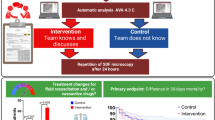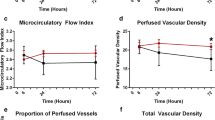Abstract
Heart failure is a growing epidemic, which is associated with increased morbidity and mortality alongside increasing healthcare costs. Left ventricular assist devices (LVADs) are increasingly used as an acceptable alternative to heart transplantation. The 2-year survival using the most technologically advanced LVAD design is nearly similar to that of heart transplantation. The pathophysiological basis of heart failure includes compromised central hemodynamics, and impaired organ perfusion and, consequently, microvascular perfusion. Previous studies on microcirculation imaging have shown that alterations in the microcirculation have important prognostic value in patients with advanced heart failure (cardiogenic shock) as well as those receiving mechanical circulatory support. Postoperative care of LVAD patients is typically associated with prolonged ICU stay due to the high surgical risk as well as the high rate of operative and device-related complications. Anticipation and handling of post-LVAD complications require hemodynamic monitoring as well as possibly adjustment of pump settings. A key marker of optimal LVAD settings is improved organ perfusion. Therefore, monitoring of end-organ function to optimize pump settings could improve care of LVAD patients and possibly avoid repeated and lengthy hospitalizations. Microcirculatory imaging is evolving as an important bedside tool for the assessment of hemodynamic coherence and microcirculatory monitoring. Several imaging techniques, such as handheld microscopes based on incident dark-field illumination (IDF), have been introduced for clinical use. In this chapter, we discuss optimal approaches to microcirculatory monitoring from the ICU to the outpatient clinic in patients with an LVAD.
Access this chapter
Tax calculation will be finalised at checkout
Purchases are for personal use only
Similar content being viewed by others
References
Savarese G, Lund LH. Global public health burden of heart failure. Card Fail Rev. 2017;3:7–11.
den Uil CA, Lagrand WK, van der Ent M, et al. Impaired microcirculation predicts poor outcome of patients with acute myocardial infarction complicated by cardiogenic shock. Eur Heart J. 2010;31:3032–9.
den Uil CA, Maat AP, Lagrand WK, et al. Mechanical circulatory support devices improve tissue perfusion in patients with end-stage heart failure or cardiogenic shock. J Heart Lung Transplant. 2009;28:906–11.
Ocak I, Kara A, Ince C. Monitoring microcirculation. Best Pract Res Clin Anaesthesiol. 2016;30:407–18.
Aykut G, Veenstra G, Scorcella C, Ince C, Boerma C. Cytocam-IDF (incident dark field illumination) imaging for bedside monitoring of the microcirculation. Intensive Care Med Exp. 2015;3:40.
van Elteren HA, Ince C, Tibboel D, Reiss IK, de Jonge RC. Cutaneous microcirculation in preterm neonates: comparison between sidestream dark field (SDF) and incident dark field (IDF) imaging. J Clin Monit Comput. 2015;29:543–8.
Hilty MP, Guerci P, Ince Y, Toraman F, Ince C. MicroTools enables automated quantification of capillary density and red blood cell velocity in handheld vital microscopy. Commun Biol. 2019;2:217.
Kara A, Akin S, Ince C. Monitoring microcirculation in critical illness. Curr Opin Crit Care. 2016;22:444–52.
Ince C. Hemodynamic coherence and the rationale for monitoring the microcirculation. Crit Care. 2015;19(Suppl 3):S8.
Akin S, Ince C, Den Uil CA, et al. A novel method for early identification of cardiac tamponade in patients with continuous flow left ventricular assist devices by use of sublingual microcirculatory imaging. Eur Heart J. 2018;39(Suppl 1):P5122 (abst).
Elbers PW, Ince C. Mechanisms of critical illness—classifying microcirculatory flow abnormalities in distributive shock. Crit Care. 2006;10:221.
Ince C, Sinaasappel M. Microcirculatory oxygenation and shunting in sepsis and shock. Crit Care Med. 1999;27:1369–77.
Kara A, Akin S, Dos Reis Miranda D, et al. Microcirculatory assessment of patients under VA-ECMO. Crit Care. 2016;20:344.
Akin S, Dos Reis Miranda D, Caliskan K, et al. Functional evaluation of sublingual microcirculation indicates successful weaning from VA-ECMO in cardiogenic shock. Crit Care. 2017;21:265.
Adamson PB, Abraham WT, Stevenson LW, et al. Pulmonary artery pressure-guided heart failure management reduces 30-day readmissions. Circ Heart Fail. 2016;9:e002600.
Akin S, Soliman OII, Muslem R, et al. Preoperative right heart hemodynamics predict right heart failure and early ICU mortality following LVAD implantation. Eur Heart J. 2017;38(Suppl 1):4993 (abst).
Reggiori G, Occhipinti G, De Gasperi A, Vincent JL, Piagnerelli M. Early alterations of red blood cell rheology in critically ill patients. Crit Care Med. 2009;37:3041–6.
Atasever B, Boer C, Goedhart P, et al. Distinct alterations in sublingual microcirculatory blood flow and hemoglobin oxygenation in on-pump and off-pump coronary artery bypass graft surgery. J Cardiothorac Vasc Anesth. 2011;25:784–90.
Dunser MW, Ruokonen E, Pettila V, et al. Association of arterial blood pressure and vasopressor load with septic shock mortality: a post hoc analysis of a multicenter trial. Crit Care. 2009;13:R181.
Boerma EC, van der Voort PH, Ince C. Sublingual microcirculatory flow is impaired by the vasopressin-analogue terlipressin in a patient with catecholamine-resistant septic shock. Acta Anaesthesiol Scand. 2005;49:1387–90.
Akin S, Soliman OI, Constantinescu AA, et al. Haemolysis as a first sign of thromboembolic event and acute pump thrombosis in patients with the continuous-flow left ventricular assist device HeartMate II. Neth Heart J. 2016;24:134–42.
Uriel N, Adatya S, Maly J, et al. Clinical hemodynamic evaluation of patients implanted with a fully magnetically levitated left ventricular assist device (HeartMate 3). J Heart Lung Transplant. 2017;36:28–35.
Uriel N, Burkhoff D, Rich JD, et al. Impact of hemodynamic ramp test-guided HVAD speed and medication adjustments on clinical outcomes. Circ Heart Fail. 2019;12:e006067.
Uriel N, Morrison KA, Garan AR, et al. Development of a novel echocardiography ramp test for speed optimization and diagnosis of device thrombosis in continuous-flow left ventricular assist devices: the Columbia ramp study. J Am Coll Cardiol. 2012;60:1764–75.
Uriel N, Sayer G, Addetia K, et al. Hemodynamic ramp tests in patients with left ventricular assist devices. JACC Heart Fail. 2016;4:208–17.
Akin S, Muslem R, Constantinescu AA, et al. 18F-FDG PET/CT in the diagnosis and management of continuous flow left ventricular assist device infections: a case series and review of the literature. ASAIO J. 2018;64:e11–9.
Kawabori M, Kurihara C, Critsinelis AC, et al. Gastrointestinal bleeding After HeartMate II or HVAD implantation: incidence, location, etiology, and effect on survival. ASAIO J. 04 Apr 2019; https://doi.org/10.1097/MAT.0000000000000998 [Epub ahead of print].
Chung MJ, Ganapathi AM, Vora AN, Schroder JN, Kiefer TL, Hughes GC. Valve-in-ring transcatheter aortic valve replacement after left ventricular assist device therapy. Ann Thorac Surg. 22 Aug 2019; https://doi.org/10.1016/j.athoracsur.2019.06.094 [Epub ahead of print].
Acknowledgment
We would like to thank Aysima Şenyürek (medical student from the Erasmus MC of Rotterdam) for her help with the creation of Fig. 18.1.
Author information
Authors and Affiliations
Corresponding author
Editor information
Editors and Affiliations
Rights and permissions
Copyright information
© 2020 Springer Nature Switzerland AG
About this chapter
Cite this chapter
Akin, S., Soliman, O.I., Ince, C. (2020). Customized Monitoring of the Microcirculation in Patients with a Left Ventricular Assist Device. In: Vincent, JL. (eds) Annual Update in Intensive Care and Emergency Medicine 2020. Annual Update in Intensive Care and Emergency Medicine. Springer, Cham. https://doi.org/10.1007/978-3-030-37323-8_18
Download citation
DOI: https://doi.org/10.1007/978-3-030-37323-8_18
Published:
Publisher Name: Springer, Cham
Print ISBN: 978-3-030-37322-1
Online ISBN: 978-3-030-37323-8
eBook Packages: MedicineMedicine (R0)




